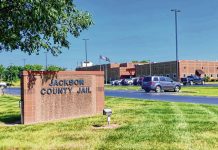The first phase of a project expected to breathe new life into the city’s east side will continue into 2017.
The initial work in the State Street Revitalization Project centers on the Haw Creek Bridge, connecting downtown Columbus and the east side of the city.
A 10-foot walk path is being installed on the north side of the bridge at an estimated cost of $2.1 million, said City Councilman Dascal Bunch, who represents the city’s east side.
Two feet is also being added to the back of the railing on the bridge to accommodate a walking path, while the road median is being reduced cut in half to 2 feet wide.
[sc:text-divider text-divider-title=”Story continues below gallery” ]
Since work began Nov. 4, motorists in the area have been restricted to two westbound lanes and one eastbound lane, while McKinley Avenue has also been closed. Work was scheduled to be wrapped up by Friday, but delays in getting materials from suppliers mean crews will continue working on the project into the new year, redevelopment director Heather Pope said Tuesday.
City officials modified the State Street project this summer to include a corridor from the downtown Columbus riverfront area to the east side. The change will link an urban trail from Mill Race Park along Fifth Street all the way to the city’s east side.
The path for the project will direct walkers and bicyclists from the park along an urban trail on Fifth Street past some of the city’s most well-known architectural landmarks, including First Christian Church and the Bartholomew County Public Library.
The trail will then head south along California Street to Third Street, where it intersects with State Street. From there, the redevelopment corridor continues east along State Street to near Mapleton Street on the east side.
The urban trail is part of the fourth phase of planned improvements and is estimated to cost $5 to $6 million. No timeline has yet been established for the work, Pope said.
Features along the State Street corridor will match the look of other significant areas of Columbus, including downtown, she said. The city plans to use the same type of pavers that are along Washington Street.
The pavers will be able to be seen in the gateway area and at each of the ramps along the northern side of the street from Central to Indiana avenues, Pope said. In addition, pavers also will be used along the multi-use trail to provide a visual barrier between the edge of the trail and the road.
The city also plans to use red for the vertical elements of the bridge to match the Robert N. Stewart Bridge on Jonathan Moore Pike and the Interstate 65 bridge, Pope said.
Anticipating impact
The State Street area has been in need of revitalization, and the project is expected to help pave the way for a more vibrant retail district, said Julie Bilz, president of the State Street Area Association and program chair of the School of Education at Ivy Tech Community College.“Those are all things that would make it a better place to live and for people to appreciate that side of town,” she said.
Bilz said several teams have attempted to get work started on State Street during the past 20 years.
When the current State Street project was launched July 1, 2014, as part of the city’s comprehensive plan, some east side residents weren’t convinced anything of substance would come out of it, she said.
“There was a lot of doubt, a lot of skepticism, from residents on that side of town about revitalization,” Bilz said.
However, Bilz said she expects perceptions will change with visual evidence of progress on the bridge.
The improvements being made will also result in a modular wall being developed near the Cummins Technical Center that will serve as an overlook featuring statues, brick pavers and benches, said Joe Skibinski of Columbus-based Force Construction Co., which was awarded the construction bid for the project.
Illuminated lights off the bridge tiers are also planned as part of the overall scope of work, Skibinski said.
“The bridge will be visually stimulating to the eye,” he said.
Appearance of the State Street area will also get an overhaul through other stages of the redevelopment project.
The second phase, estimated to cost $3 million to $4 million, will result in new six-foot-wide pedestrian sidewalks on the south side of the bridge, along with an eight-foot multi-use trail on the north side with decorative elements.
Pope said the city anticipates beginning on that part of the work in May with the hope it can be completed by next winter. Funding for that phase, however, has not yet been approved.
Julie Aton, owner of Aton Self Storage and a member of the State Street Association, said it is good to see progress taking place along State Street, calling the work is long overdue.
Aton also said other developments are already taking shape in the area, pointing to an apartment complex under construction next to her business.
“We’re just now starting to see the benefits of all the hard work people have done in the past,” Bunch said.
Wally Veluzat, owner of Awesome Finds & Collectibles, also said he believes the changes along State Street will be helpful in drawing more people and services to the area.
“Everybody wins when there’s more traffic,” Veluzat said. “If they continue with the project, it will make more businesses want to come to this side of town.”
[sc:pullout-title pullout-title=”State Street project timeline” ][sc:pullout-text-begin]
First phase: Began Nov. 4, expected to be continue into 2017 at a cost of $2.1 million. Funding is coming from the city’s Central Tax Increment Financing District, which collects property taxes from new development and increased property values in a selected geographic area.
Second phase: Work expected to begin in May to completed by next winter. Funding has not yet been approved, but is estimated to cost $3 million to $4 million.
Third/fourth phases: The third phase was removed from the project, but the fourth phase is estimated to cost $5 to $6 million. No timeline has been established.
[sc:pullout-text-end]




